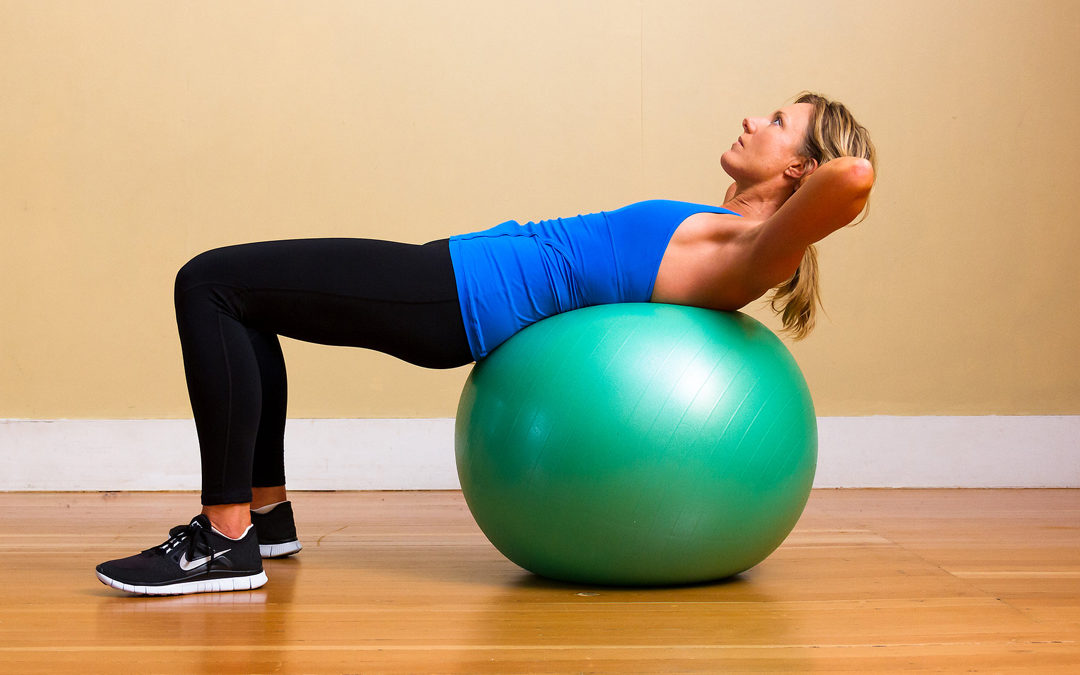Many treatment programs for low back pain incorporate use of an exercise ball (also called a stability or fitness ball) to strengthen the core muscles in the stomach and back that support the spine. Exercise ball exercises clearly work and have been adopted in non‐rehabilitation exercise programs by athletes and fitness buffs looking to cross‐train and strengthen their core muscles.
This article provides several simple steps to choose, get familiar with, and benefit from using an exercise ball on a regular basis.
Choosing the Right Exercise Ball
Physical therapists, exercise trainers, Chiropractors, and other professionals have constructed several guidelines to use when selecting the proper exercise ball size.
When sitting upright on an exercise ball:
- Feet should be flat on the floor – with an even weight distribution.
- Knees should be level or slightly lower than the pelvis – creating an angle of 90 degrees or slightly greater at the hips and knees (thighs parallel to ground or pointing down slightly).
- Pelvis, shoulders, and ears should be in a vertical line — the body should not be leaning in any direction as a counter-balance. Bouncing up and down lightly will usually produce this alignment.
Exercise balls generally come in five different diametrical sizes to be accordingly used by people of differing body compositions.
It is important to note that height alone is not the only factor in determining ball size. Because the exercise balls are flexible and offer resistance, weight is also an important factor.
A general guideline for height correspondence to diameter of exercise ball is as follows (assuming average body weight is proportional to height):
| Ball Diameter | Your Height |
|---|---|
| 45cm | 5′ and under |
| 55cm | 5’1″ – 5’8″ |
| 65cm | 5’9″ – 6’2″ |
| 75cm | 6’3″ – 6’7″ |
| 85cm | 6’8″ & taller |
If body weight to height is larger than the average proportion, sitting on the exercise ball will compress it down more, so try using the next larger exercise ball size in order to maintain the 90-degree rule. Another factor to keep in mind is that most exercise ball sizes have some adjustability to them. If the angles at the hips and knees are much greater than 90 degrees, some air can be released to compensate and vice versa.
Bear in mind, releasing air from the exercise ball will cause it to lose air pressure. As the ball flattens out, this will actually make it more stable, as it has a larger contact area with the resisting surface and the body. This means that stabilizing and balancing exercises will become easier and will lose some effectiveness.
Exercise balls also lose pressure because of stretching from regular usage. Therefore, as the ball ages, it may require further inflation. On the other hand, adding excessive air to the exercise ball will increase the difficulty of balancing and stabilizing, as the contact area decreases.
Starting an Exercise Ball Program
Just sitting on an exercise ball is active and requires the core body muscles to work to hold the body upright and balanced on the ball. Until sitting on the exercise ball feels comfortable, it is often a good idea to not have the ball fully inflated – a slightly deflated exercise ball is more stable.
- Sit in the center of the ball with both feet firmly on the ground about shoulder width apart. If this is difficult, then use a wider stance.
- The knees should be in line over the ankles.
- Shoulders should be in line over the body (not hunching forward) and the head squarely over the neck (not leaning forward).
One can easily sit on the exercise ball while working at a desk or computer workstation and use it as an alternative to a traditional office chair. Others prefer to sit on it while watching television. Whatever the use, sitting on an exercise ball at some point of the day is helpful to strengthen the core muscles that support the spine.
Beginning Stretches
There are several stretches that are easy to do when starting to use an exercise ball. These stretching exercises help with proprioception, or the sense of the position or parts of the body relative to the rest of the body, and with balance. Each of these stretches should be done slowly 8 to 12 times.
- Move the hips from side-to-side. While sitting on the exercise ball (as described above) and keeping the knees still, move the hips gently from side to side. Pause for a second at the end of each sideways movement to allow for a gentle stretch.
- Move hips from front-to-back. While keeping the knees still, place hands on the knees and rotate the hips forward by tucking the buttocks first under the pelvis, and then push them out behind the pelvis. All the motion should be limited to the hip area, not the knees or chest.
For more exercise ball routines and exercises, visit: Spine Health
